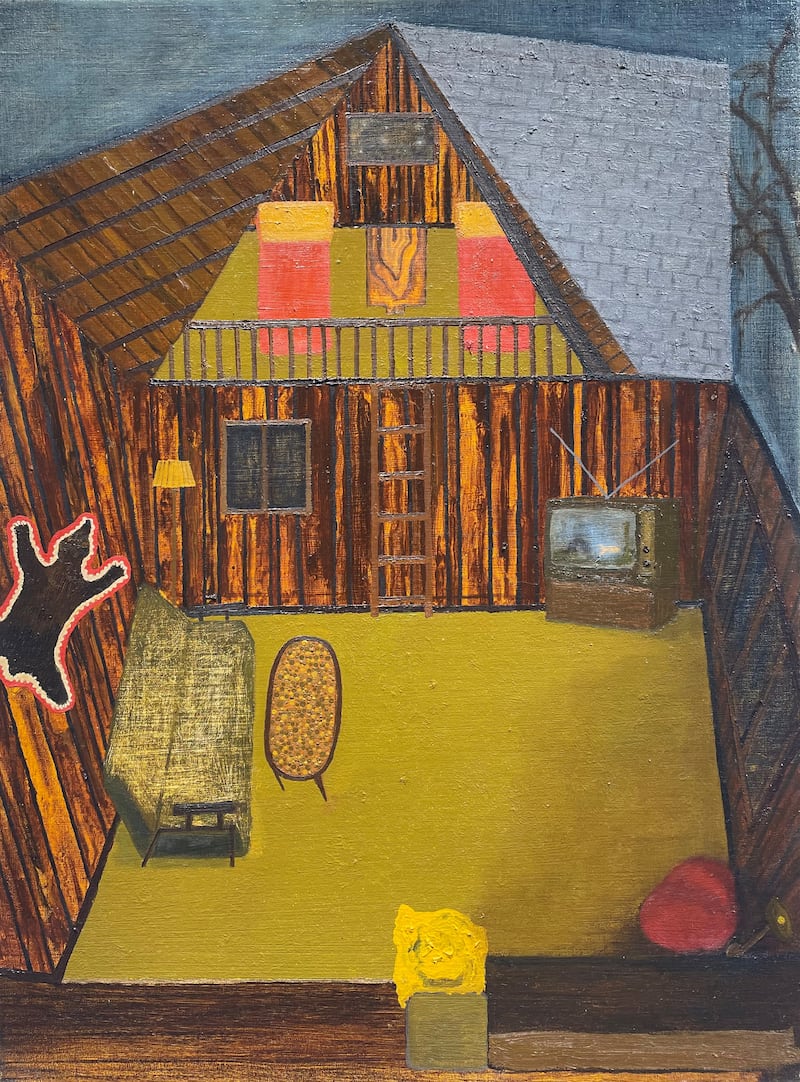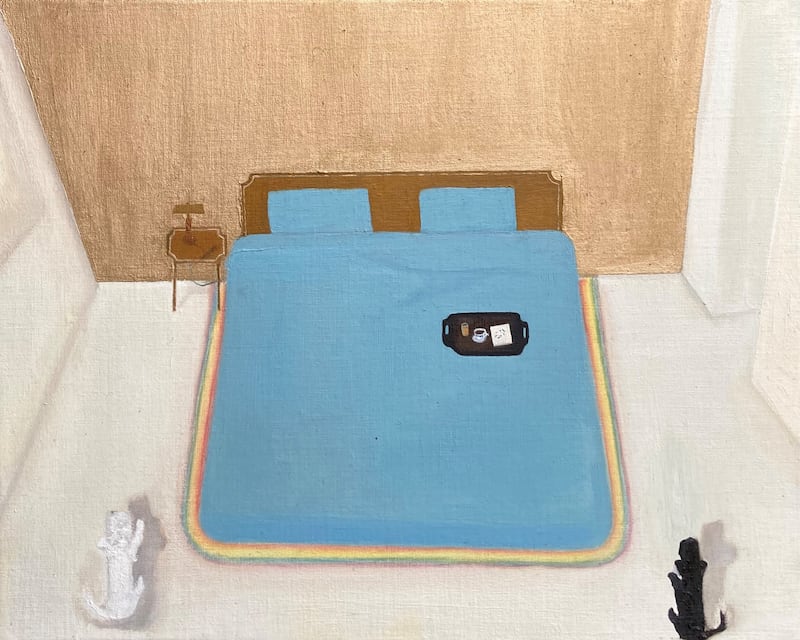By the time I had met Mollie Douthit every one of our grandparents was already dead.
We calculated the chronological order of their deaths in my car one afternoon, in the no-man’s-land of dual-carriageway approaching the tunnel under the river Lee. We were stuck in traffic and had covered a miscellany of topics since I picked her up at the mouth of her overgrown track. Mollie and I did all of our best talking in my car, with the dogs on the back seat and our damp, sandy beach towels in the boot and the crumbs of her home-baked biscuits scattered across our laps. We calculated that my paternal grandmother had been the last to go, dying of Covid in a nursing home in Northumberland on the winter solstice of 2020. What I found sadder than her death was the fact that she had spent most of the final year of her life in forced isolation, and I told Mollie this, cutting directly to the emotional core of the subject, as had become our habit.
That afternoon in the traffic was not the first time Mollie and I had talked about our grandparents. The first time had been months earlier; we were in my car again, driving in a loop around a peninsula, when we discovered that we each felt an exceptional attachment to our respective maternal grandmothers. The road was steep, barely as wide as my bonnet, and there was a lot of cloud banked up in the sky outside the windscreen that day, and small, lumpy fields that tumbled down into cliffs that tumbled down into sea. We discovered that I happened to be, at that time, writing about my grandmother, and that Mollie happened to be making a series of paintings about hers.
She was called Eileen, Mollie told me, and had been born in England but married an American and went to live in North Dakota where she ran a restaurant, started a family and, finally, in the 1960s bought a holiday home by picturesque Pelican Lake in Minnesota. When I asked Mollie why she felt a bond with this particular grandparent she told me that Eileen had won a scholarship to attend art school, but had to give it up because she contracted tuberculosis. She was the only one of her sisters to leave Wandsworth in south London, relocating thousands of miles from home. They were bonded by painting, and by a common spirit of curiosity and intrepidness, but while Eileen had crossed the Atlantic Ocean in pursuit of the American dream, Mollie had travelled in the opposite direction, seeking to escape it.
RM Block
I saw a photograph of Eileen the first time I visited Mollie’s cabin in the countryside outside Ballydehob. The cabin, half-sunk into a grassy slope at the end of a winding track, struck me as a rather magical place to live, a dwelling cut from the pages of a children’s storybook. The photograph was in a gilded frame which seemed excessively decorative considering the informal nature of the snapshot. Eileen was not posing; instead she appeared to have been caught off-guard, sitting at a crowded table in a restaurant, leaning forward to talk to someone whose face was not visible. She did not look very grandmotherly – her hair was cropped and dark; she wore a pair of stylishly over-sized glasses and a pink silk shirt.

The first time I visited the cabin, Mollie had put out the paintings she was working on to show me. They were mostly propped up on the floor and along the narrow, cushioned bench that substituted for a sofa, occupying the same cramped spaces where she had variously sat cross-legged and crouched and laid flat on her belly to attend to them. I would visit these paintings again and again over the weeks that followed; I would watch as they filled up and emptied out and changed. In most cases their setting was a version of the holiday home on Pelican Lake where Mollie had spent summers as a child in the 1980s and 1990s.
[ Sara Baume: I was so tired of my laptop, I felt compelled to work with my handsOpens in new window ]
The architecture of the house and the landscaping of its surrounds were extraordinary for any era. There was a red deck, a rock garden, paper screens walls, decorative railings inside and out. The paintings were notably devoid of people and simultaneously humming with human presence. It was as if people had just stepped off the edge of the canvas, or were about to step in. The shadow of a head touches the corner of a bathmat; a platter of pills waits on a blue bedspread to be swallowed with coffee and orange juice. I should have expected these absences because so many of Mollie’s earlier paintings contain vacant chairs – chairs of unusual design, or of importance to a loved one; chairs that defined a special occasion, or an ordinary occasion that only came to seem special with the passing of time – after Mollie had moved state, and then moved continent; after the places that staged the occasions were no longer recognisable, and the people who stepped in and out of the canvases had died.

I was surprised by how clearly she was able to remember the layout of rooms, the arrangement of furnishings, the details of objects, but perhaps it would not have been so impressive if I had been there with her – in the house on Pelican Lake, in the past – perhaps I would have remembered it differently. Increasingly often during my visits and our car journeys Mollie talked about “bridging truth and fiction” in her paintings. New details started to overlay old scenes; reality intruded upon the past. In one painting a Doberman Pinscher called Venus that had belonged to her mother before Mollie was born is portrayed as if afloat in space. The painting is a second-hand memory, she told me, Venus unexpectedly gave birth to seven puppies and so each one was named after a planet in the solar system.
When I was a child my maternal grandmother lived in the village of Ballycotton on the east Cork coast. Her house was named Altair after the 12th brightest star in the night sky and it was a weird house – the bedrooms were downstairs and the kitchen was upstairs; there was a spiral staircase, multiple attics, heavy velvet curtains instead of walls, little flights of steps separating rooms. I was devastated when it was sold in the late 1990s but I had not thought about it much in recent years until Mollie’s paintings brought it flooding back – the peculiar architecture and décor, but most of all, the atmosphere – and I was compelled, one day alone at my desk, to Google the address. It had been sold, I discovered, in 2020 and in 2021 permission had been sought to demolish it, and granted.
I slumped in my chair, on hearing that news, and cried like a child. It dawned on me that I had subconsciously believed, for decades, that one day I would go back to Ballycotton and live in Altair exactly as it had been – that my grandmother would be there again, or perhaps that I would have become my grandmother – the idea was as crumbling and jarring and as difficult to articulate as a dream, but the sense of loss was strangely acute.
Where were we going – Mollie and I – that day in the car out the peninsula when we first talked about our grandparents; where had we just come from? The journey drifts in my memory, unattached to any of our usual shared activities – a walk, a swim, a lunch. There was a day we picked sea-spinach on a little strand close to the peninsula. It was raining heavily and so we sat in the parked car waiting for a break in the showers, then bolted down the puddled track and stuffed our plastic bags full of the glossy foliage. But it can’t have been that day because there weren’t any raindrops on the windscreen in my memory – the whiteness of the clouded sky was abundantly present – and so it must have been a different time.
For some reason it was not until the traffic jam on the dual-carriageway, the descent to the mouth of the tunnel, that I thought to ask Mollie what had become of her grandparents’ house on Pelican Lake. It had also been sold, years ago, and she’d never gone back and never wanted to, which I could, of course, understand. And then we talked about our dreams – or maybe that was another time altogether; maybe my mind just wandered and I never said a word out loud – but the way I remember it is that, as the headlamps came on and we dropped down into the dark tunnel beneath the deep river, we talked about our dreams and I told Mollie how, in recent years, I have cultivated the belief, appropriated mainly from America’s indigenous people, that our dreams are a different world that we go to when we sleep, no less real than the waking one, and in which our dead loved ones, though elusive, still exist – my dog, my dad, and all of our grandparents.
Sara Baume is a writer based in West Cork, and Mollie Douthit is a painter, originally from North Dakota, now also based in Cork. Her solo exhibition Dreams are important opens in the Molesworth Gallery on September 7th and runs until the 29th





















